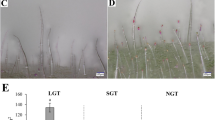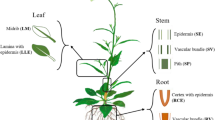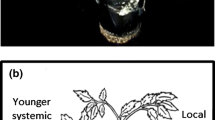Abstract
Trichomes contribute to plant resistance against herbivory by physical and chemical deterrents. To better understand their role in plant defense, we systemically studied trichome morphology, chemical composition and the response of the insect herbivores Helicoverpa zea and Leptinotarsa decemlineata (Colorado potato beetle = CPB) on the tomato hairless (hl), hairy (woolly) mutants and wild-type Rutgers (RU) and Alisa Craig (AC) plants. Hairless mutants showed reduced number of twisted glandular trichomes (types I, IV, VI and VII) on leaf and stem compared to wild-type Rutgers (RU), while woolly mutants showed high density of non-glandular trichomes (types II, III and V) but only on the leaf. In both mutants, trichome numbers were increased by methyl jasmonate (MeJA), but the types of trichomes present were not affected by MeJA treatment. Glandular trichomes contained high levels of monoterpenes and sesquiterpenes. A similar pattern of transcript accumulation was observed for monoterpene MTS1 (=TPS5) and sesquiterpene synthase SST1 (=TPS9) genes in trichomes. While high density of non-glandular trichome on leaves negatively influenced CPB feeding behavior and growth, it stimulated H. zea growth. High glandular trichome density impaired H. zea growth, but had no effect on CPB. Quantitative real-time polymerase chain reaction (qRT-PCR) showed that glandular trichomes highly express protein inhibitors (PIN2), polyphenol oxidase (PPOF) and hydroperoxide lyase (HPL) when compared to non-glandular trichomes. The SlCycB2 gene, which participates in woolly trichome formation, was highly expressed in the woolly mutant trichomes. PIN2 in trichomes was highly induced by insect feeding in both mutant and wild-type plants. Thus, both the densities of trichomes and the chemical defenses residing in the trichomes are inducible.








Similar content being viewed by others
Abbreviations
- woolly :
-
Hairy mutant
- hl :
-
Hairless mutant
- RU:
-
Rutgers wild-type plants of woolly mutant
- AC:
-
Alisa Craig, wild-type plants of hairless mutant
- MeJA:
-
Methyl jasmonate
- PIN2:
-
Protease inhibitor 2
- HPL:
-
Hydroperoxide lyase
- SlCycB2:
-
B-type cyclin
- PPOF:
-
Polyphenol oxidase
- CPB:
-
Colorado potato beetle
References
Agrawal AA (1999) Induced responses to herbivory in wild radish: effects on several herbivores and plant fitness. Ecology 80:1713–1723
Agrawal AA, Conner JK, Johnson MTJ, Wallsgrove R (2002) Ecological genetics of an induced plant defense against herbivores: additive genetic variance and costs of phenotypic plasticity. Evolution 56:2206–2213
Ågren J, Schemske DW (1994) Evolution of trichome number in a naturalized population of Brassica rapa. Am Nat 143(1):1–13
Alba JM, Montserrat M, Fernandez-Munoz R (2009) Resistance to the two-spotted spider mite (Tetranychus urticae) by acylsucroses of wild tomato (Solanum pimpinellifolium) trichomes studied in a recombinant inbred line population. Exp Appl Acarol 47:35–47
Amin MR, Tithi DA, Kwon YJ (2011) Characteristics of three cotton varieties and their impact on feeding and growth of cotton armyworm. Entomol Res 41:151–156
Arimura GI, Kost C, Boland W (2005) Herbivore-induced, indirect plant defences. Biochim Biophys Acta (BBA) Mol Cell Biol Lipids 1734:91–111
Baur R, Binder S, Benz G (1991) Non-glandular leaf trichomes as short-term inducible defense of the grey alder, Alnus incana (L.), against the chrysomelid beetle, Agelastica alni L. Oecologia 87:219–226
Besser K, Harper A, Welsby N, Schauvinhold I, Slocombe S, Li Y, Dixon RA, Broun P (2009) Divergent regulation of terpenoid metabolism in the trichomes of wild and cultivated tomato species. Plant Physiol 149:499–514
Bostock RM (2005) Signal crosstalk and induced resistance: straddling the line between cost and benefit. Annu Rev Phytopathol 43:545–580
Boughton AJ, Hoover K, Felton GW (2005) Methyl jasmonate application induces increased densities of glandular trichomes on tomato, Lycopersicon esculentum. J Chem Ecol 31:2211–2216
Campos ML, de Almeida M, Rossi ML, Martinelli AP, Litholdo CG, Figueira A, Rampelotti-Ferreira FT, Vendramim JD, Benedito VA, Peres LEP (2009) Brassinosteroids interact negatively with jasmonates in the formation of anti-herbivory traits in tomato. J Exp Bot 60:4346–4360
Chippendale G (1970) Development of artificial diets for rearing the Angoumois grain moth. J Econ Entomol 63:844–848
Chung SH, Felton GW (2011) Specificity of induced resistance in tomato against specialist Lepidopteran and Coleopteran species. J Chem Ecol 37:378–386
Creelman RA, Mullet JE (1995) Jasmonic acid distribution and action in plants: regulation during development and response to biotic and abiotic stress. Proc Natl Acad Sci USA 92:4114–4119
Dalin P, Björkman C (2003) Adult beetle grazing induces willow trichome defence against subsequent larval feeding. Oecologia 134:112–118
Dalin P, Björkman C, Eklund K (2004) Leaf beetle grazing does not induce willow trichome defence in the coppicing willow Salix viminalis. Agric For Entomol 6:105–109
Dalin P, Ågren J, Björkman C, Huttunen P, Kärkkäinen K (2008) Leaf trichome formation and plant resistance to herbivory. In: Schaller A (ed) Induced plant resistance to herbivory, pp 89–105
Dimock MB, Kennedy GG, Williams WG (1982) Toxicity studies of analogs of 2-tridecanone, a naturally-occurring toxicant from a wild tomato. J Chem Ecol 8:837–842
Duffey SS (1986) Plant glandular trichomes: their partial role in defence against insects. In: Juniper BE, Southwood TE (eds) Insects and the plant surface Arnold. England, London, pp 151–172
Felton GW, Workman J, Duffey SS (1992) Avoidance of antinutritive plant defense—role of midgut pH in Colorado potato beetle. J Chem Ecol 18:571–583
Felton GW, Bi JL, Summers CB, Mueller AJ, Duffey SS (1994) Potential role of lipoxygenases in defense against insect herbivory. J Chem Ecol 20:651–666
Fridman E, Wang JH, Iijima Y, Froehlich JE, Gang DR, Ohlrogge J, Pichersky E (2005) Metabolic, genomic, and biochemical analyses of glandular trichomes from the wild tomato species Lycopersicon hirsutum identify a key enzyme in the biosynthesis of methylketones. Plant Cell 17:1252–1267
Gang DR, Wang J, Dudareva N, Nam KH, Simon JE, Lewinsohn E, Pichersky E (2001) An investigation of the storage and biosynthesis of phenylpropenes in sweet basil. Plant Physiol 125:539–555
Goffreda JC, Mutschler MA, Ave DA, Tingey WM, Steffens JC (1989) Aphid deterrence by glucose esters in glandular trichome exudate of the wild tomato, Lycopersicon pennellii. J Chem Ecol 15:2135–2147
Green TR, Ryan CA (1972) Wound-induced proteinase inhibitor in plant leaves: a possible defense mechanism against insects. Science 175:776–777
Gutiérrez-Alcalá G, Gotor C, Meyer AJ, Fricker M, Vega JM, Romero LC (2000) Glutathione biosynthesis in Arabidopsis trichome cells. Proc Natl Acad Sci USA 97:11108–11113
Handley R, Ekbom B, Agren J (2005) Variation in trichome density and resistance against a specialist insect herbivore in natural populations of Arabidopsis thaliana. Ecol Entomol 30:284–292
Heinz KM, Zalom FG (1995) Variation in trichome-based resistance to bemisia-argentifolii (Homoptera, Aleyrodidae) oviposition on tomato. J Econ Entomol 88:1494–1502
Holeski LM (2007) Within and between generation phenotypic plasticity in trichome density of Mimulus guttatus. J Evol Biol 20:2092–2100
Horgan FG, Quiring DT, Lagnaoui A, Pelletier Y (2009) Effects of altitude of origin on trichome-mediated anti-herbivore resistance in wild andean potatoes. Flora 204:49–62
Howe GA, Jander G (2008) Plant immunity to insect herbivores. Annu Rev Plant Biol 59:41–66
Ishida T, Kurata T, Okada K, Wada T (2008) A genetic regulatory network in the development of trichomes and root hairs. Annu Rev Plant Biol 59:365–386
Johnson KS, Felton GW (1996) Potential influence of midgut pH and redox potential on protein utilization in insect herbivores. Arch Insect Biochem Physiol 32:85–105
Kang JH, Liu G, Shi F, Jones AD, Beaudry RM, Howe GA (2010a) The tomato odorless-2 mutant is defective in trichome-based production of diverse specialized metabolites and broad-spectrum resistance to insect herbivores. Plant Physiol 154:262–272
Kang JH, Shi F, Jones AD, Marks MD, Howe GA (2010b) Distortion of trichome morphology by the hairless mutation of tomato affects leaf surface chemistry. J Exp Bot 61:1053–1064
Karban R, Baldwin IT (1997) Induced responses to herbivory. University of Chicago Press, Chicago
Kennedy GG (2003) Tomato, pests, parasitoids, and predators: tritrophic interactions involving the genus Lycopersicon. Annu Rev Entomol 48:51–72
Kessler A, Baldwin IT (2002) Plant responses to insect herbivory: the emerging molecular analysis. Annu Rev Plant Biol 53:299–328
Larocca A, Fanti P, Molinaro A, Mattia MF, Battagli D (2011) Aphid performance on Vicia faba and two southern Italy Phaseolus vulgaris landraces. Bull Insectol 64:101–106
Levin DA (1973) The role of trichomes in plant defense. Quart Rev Biol 48:3–15
Li AX, Eannetta N, Ghangas GS, Steffens JC (1999) Glucose polyester biosynthesis. Purification and characterization of a glucose acyltransferase. Plant Physiol 121:453–460
Li L, Zhao YF, McCaig BC, Wingerd BA, Wang JH, Whalon ME, Pichersky E, Howe GA (2004) The tomato homolog of CORONATINE-INSENSITIVE1 is required for the maternal control of seed maturation, jasmonate-signaled defense responses, and glandular trichome development. Plant Cell 16:126–143
Luckwill LC (1943) The genus Lycopersicon: a historical, biological and taxonomic survey of the wild and cultivated tomato. Aberd Univ Stud 120:1–44
Mirnezhad M, Romero-Gonzalez RR, Leiss KA, Choi YH, Verpoorte R, Klinkhamer PGL (2010) Metabolomic analysis of host plant resistance to thrips in wild and cultivated tomatoes. Phytochem Anal 21:110–117
Nonamua T, Xu L, Wada M, Kawamura S, Miyajima T, Nishitoni A, Kakutan K, Takikawa Y, Matsuda Y, Toyoda H (2008) Trichome exudates of Lycopersicon pennellii form a chemical barrier to suppress leaf-surface germination of Oidium neolycopersici conidia. Plant Sci 176:31–37
O’Donnell PJ, Calvert C, Atzorn R, Wasternack C, Leyser HMO, Bowles DJ (1996) Ethylene as a signal mediating the wound response of tomato plants. Science 274:1914–1917
Peiffer M, Felton GW (2005) The host plant as a factor in the synthesis and secretion of salivary glucose oxidase in larval Helicoverpa zea. Arch Insect Biochem Physiol 58:106–113
Peiffer M, Tooker JF, Luthe DS, Felton GW (2009) Plants on early alert: glandular trichomes as sensors for insect herbivores. New Phytol 184:644–656
Pelletier Y, Dutheil J (2006) Behavioural responses of the Colorado potato beetle to trichomes and leaf surface chemicals of Solanum tarijense. Entomol Exper Appl 120:125–130
Rasmann S, De Vos M, Casteel CL, Tian D, Halitschke R, Sun JY, Agrawal AA, Felton GW, Jander G (2012) Herbivory in the previous generation primes plants for enhanced insect resistance. Plant Physiol 158(2):854–863
Reeves AF (1977) Tomato trichomes and mutations affecting their development. Am J Bot 64:186–189
Rotenberg D, Thompson TS, German TL, Willis DK (2006) Methods for effective real-time RT-PCR analysis of virus-induced gene silencing. J Virol Methods 138:49–59
Ryan CA (1990) Proteinase inhibitors in plants: genes for improving defenses against insects and pathogens. Annu Rev Phytopathol 28:425
Schilmiller A, Shi F, Kim J, Charbonneau AL, Holmes D, Jones AD, Last RL (2010) Mass spectrometry screening reveals widespread diversity in trichome specialized metabolites of tomato chromosomal substitution lines. Plant J 62:391–403
Simmons AT, Gurr GM (2004) Trichome-based host plant resistance of Lycopersicon species and the biocontrol agent Mallada signata: are they compatible? Entom Exper Appl 113:95–101
Simmons AT, Gurr GM (2005) Trichomes of Lycopersicon species and their hybrids: effects on pests and natural enemies. Agric Forest Entomol 7:265–276
Steffens JC, Walters DS (1991) Biochemical aspects of glandular trichome-mediated insect resistance in the Solanaceae. ACS Symp Ser 449:136–149
Thaler JS, Stout MJ, Karban R, Duffey SS (2001) Jasmonate-mediated induced plant resistance affects a community of herbivores. Ecol Entomol 26:312–324
Thipyapong P, Steffens JC (1997) Tomato polyphenol oxidase-differential response of the polyphenol oxidase F promoter to injuries and wound signals. Plant Physiol 115:409–418
Thipyapong P, Joel DM, Steffens JC (1997) Differential expression and turnover of the tomato polyphenol oxidase gene family during vegetative and reproductive development. Plant Physiol 113:707–718
Traw MB, Bergelson J (2003) Interactive effects of jasmonic acid, salicylic acid, and gibberellin on induction of trichomes in Arabidopsis. Plant Physiol 133:1367–1375
Traw MB, Dawson TE (2002) Reduced performance of two specialist herbivores (Lepidoptera: Pieridae, Coleoptera: Chrysomelidae) on new leaves of damaged black mustard plants. Environ Entomol 31:714–722
Valkama E, Koricheva J, Ossipov V, Ossipova S, Haukioja E, Pihlaja K (2005) Delayed induced responses of birch glandular trichomes and leaf surface lipophilic compounds to mechanical defoliation and simulated winter browsing. Oecologia 146:385–393
Van Schie CCN, Haring MA, Schuurink RC (2007) Tomato linalool synthase is induced in trichomes by jasmonic acid. Plant Molec Biol 64:251–263
Wagner GJ (1991) Secreting glandular trichomes—more than just hairs. Plant Physiol 96:675–679
Weinhold A, Baldwin IT (2011) Trichome-derived O-acyl sugars are a first meal for caterpillars that tags them for predation. Proc Natl Acad Sci USA 108:7855–7859
Yang CX, Li HX, Zhang JH, Luo ZD, Gong PJ, Zhang CJ, Li JH, Wang TT, Zhang YY, Lu YE, Ye ZB (2011) A regulatory gene induces trichome formation and embryo lethality in tomato. Proc Natl Acad Sci USA 108:11836–11841
Yoshida Y, Sano R, Wada T, Takabayashi J, Okada K (2009) Jasmonic acid control of GLABRA3 links inducible defense and trichome patterning in Arabidopsis. Development 136:1039–1048
Zhu-Salzman K, Luthe DS, Felton GW (2008) Arthropod-inducible proteins: broad spectrum defenses against multiple herbivores. Plant Physiol 146:852–858
Acknowledgments
The support of the United State Department of Agriculture, National Research Initiative is greatly appreciated (2007-35302-18218, awarded to G.W.F.). Tomato seeds were provided by the Tomato Genetics Resource Center (University of California, Davis, CA, USA).
Author information
Authors and Affiliations
Corresponding author
Electronic supplementary material
Below is the link to the electronic supplementary material.
425_2012_1651_MOESM3_ESM.pdf
Fig.S1. Oviposition choice on different mutants. Not significantly different among the mutants. F= 0.03, P= 0.993 for H.zea; F=0.09, P=0.967 for CPB (n=8). (PDF 9 kb)
425_2012_1651_MOESM4_ESM.pdf
Fig.S2. Oviposition of H.zea and CPB in woolly mutant. a) H.zea egg on woolly leaf surface with non-glandular trichomes. b) H.zea eggs on woolly stem with both glandular and glandular trichomes c) CPB lay eggs on underside leaf of woolly mutant. (PDF 174 kb)
Rights and permissions
About this article
Cite this article
Tian, D., Tooker, J., Peiffer, M. et al. Role of trichomes in defense against herbivores: comparison of herbivore response to woolly and hairless trichome mutants in tomato (Solanum lycopersicum). Planta 236, 1053–1066 (2012). https://doi.org/10.1007/s00425-012-1651-9
Received:
Accepted:
Published:
Issue Date:
DOI: https://doi.org/10.1007/s00425-012-1651-9




